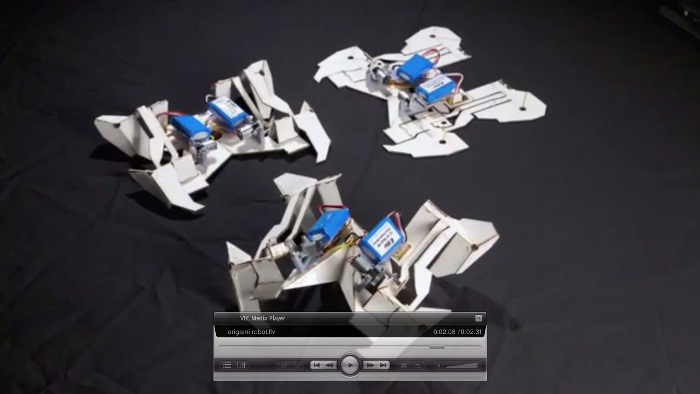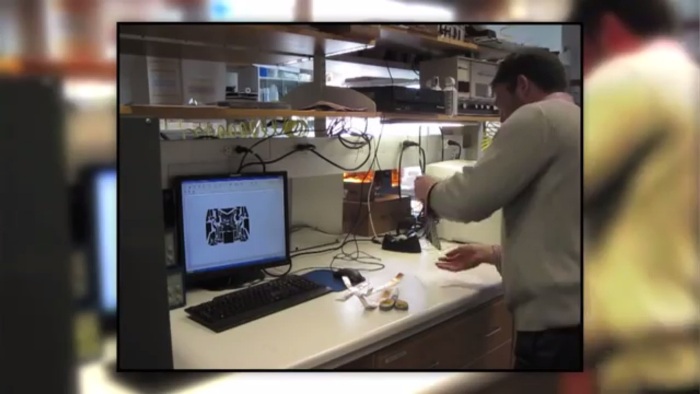The Real Life Transformer: An Origami-Inspired Robot that Folds and Moves

Screenshot of the video featuring Harvard University’s origami robot (www.seas.harvard.edu/news/2014/08/robot-folds-itself-up-and-walks-away)
The Transformers are an icon when it comes to sci-fi robotics. Unfortunately, until now, the technology necessary to create them is not yet that mature. Harvard scientists, however, have developed an origami-inspired robot dubbed as the world’s first working transformer robot. No, this robot does not disguise itself as a car. It’s not capable of doing such sophisticated transformations. It’s still a basic robot but its form and concept can be put into a variety of practical applications.
Origami Robot
Created with the help of MIT researchers, this origami-like robot is like a piece of paper or a flat white surface that folds itself into an object with four legs capable of locomotion. The prototype shown by the robot’s researchers, as featured in this video, features a flat base material created using a printer. Interestingly, the researchers involved in the projected noted how their use of origami principles is comparable to 3D printing. With origami, they can create new forms easily without the need for tedious fabrication processes. Moreover, they also mentioned how their work was inspired by the folding processes in nature that lead to creation of new shapes and forms, like the blooming of flowers.

Screenshot of the video featuring Harvard University’s origami robot (www.seas.harvard.edu/news/2014/08/robot-folds-itself-up-and-walks-away)
How Does It Work
The origami robot is made mainly of composite sheets of paper and polystyrene that have undergone laser sheening to designate the origami folding patterns. These composite sheets have also been printed with conductive channels to create a circuitry through which a microcontroller is able to connect. The microcontroller’s primary way of exerting control over the sheets is through heat in a process similar to how the polymer fiber artificial muscles work.
A pair of motors then enable locomotion. Obviously, there are batteries involved here to be able to run the motor and to produce the heat necessary to fold the origami robot into the desired shape or form. Unfortunately, the batteries and motors cannot be flattened out and made foldable without sacrificing function so you can’t expect a completely flat and thin paper-like material to magically transform into a moving robot. While the technology to create bendable and flexible batteries already exists, having powerful enough motors and very slim microcontrollers in a very thin and small form is still very difficult. It might be possible but such microcontrollers and motors may not be strong enough to do what they are meant to do.

Screenshot of the video featuring Harvard University’s origami robot (www.seas.harvard.edu/news/2014/08/robot-folds-itself-up-and-walks-away)
Self Assembly
Self assembly is touted by the Harvard researchers involved in the project as the biggest advantage of this newly developed robotic technology. It is said that one of the biggest bottlenecks in technology is the need to create and assemble everything in lengthy and meticulous processes, the inability to completely automate device assembly and deployment. The self assembly advantage demonstrated by the origami robot is expected to provide a solution to this technological bottleneck.
In theory, self assembly can lead to lower manufacturing costs. It can also minimize defects or problems attributed to inaccuracies during the manufacturing processes. These benefits have not yet been proven on a bigger scale, though, other than what Harvard’s simple origami robot is able to showcase in a rather diminutive and very simplistic scale.

Screenshot of the video featuring Harvard University’s origami robot (www.seas.harvard.edu/news/2014/08/robot-folds-itself-up-and-walks-away)
Potential Uses
The principles of the origami robot are said to be applicable in harsh or very challenging conditions wherein shipping or transportation capacity is very limited and assembly is essential. Examples of these conditions are space exploration and wars.
In space exploration, self-assembling and deploying robots like Harvard’s origami robot can be easily shipped to the target destination in a more efficient manner since they wouldn’t require too much space given their slim and stackable form before assembly and deployment. They can simply be programmed or remote controlled when they are supposed to self-assemble and deploy.
The creators are saying that their origami robot can also be used on the battlefield. The idea is that because of its versatile design, small size, light weight, and durability, it can be easily transported and discreetly deployed to war zones to perform various functions such as spying or scouting.

Screenshot of the video featuring Harvard University’s origami robot (www.seas.harvard.edu/news/2014/08/robot-folds-itself-up-and-walks-away)
Outlook
The origami robot can be considered as a step closer to the goal of producing robots or useful moving devices quickly and cheaply. As pointed out by Daniela Rus, one of the researchers involved in the project, the technology could have a major impact on manufacturing as it “will rapidly extend the manufacturing capabilities that we have today where configuring an assembly line is done manually and requires a lot of time.” It will certainly be a major convenience being able to one day go to a shop to have a self-assembling personal robot helper manufactured shortly after specifying the features and intended uses.